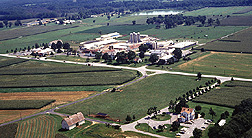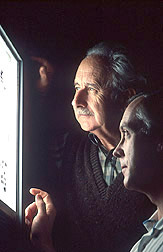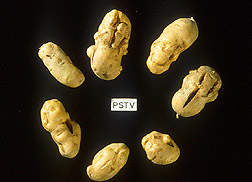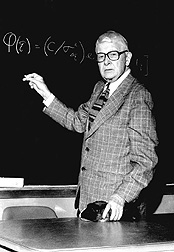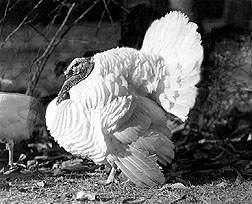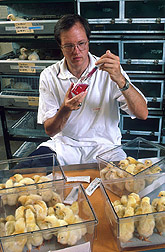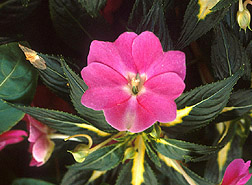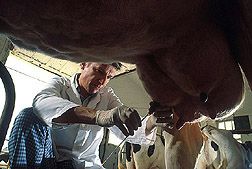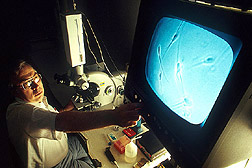Beltsville Agricultural
|
|
|
|
When the top 10 milestones for the past 100 years of plant pest and pathogen research were published by the American Phytopathological Society, two were work from scientists at the Henry A. Wallace Beltsville Agricultural Research Center (BARC), for discovery of new forms of life.
Sixth on the list was the 1972 discovery by BARC plant pathologist Robert E. Davis of spiroplasmas, mycoplasma-like life forms with no cell wall and with one of the smallest genomes of any living organism. Spiroplasmas have been found to be responsible for many plant diseases.
|
|
|
The other entry on the top-10 list was the discovery at BARC of a second new form of life—the viroid. In 1971, BARC plant pathologist Theodor O. Diener uncovered these unique, low-molecular-weight, pathogenic, RNA-only molecules, which can barely be seen with an electron microscope. Like a virus, a viroid invades cells and hijacks their reproductive mechanism.
But when Diener announced his discovery, he was overturning scientific dogma that held that an organism with no proteins couldn't replicate itself. And an entity as small as the potato spindle tuber viroid—at only 130,000 daltons—wasn't supposed to be able to infect anything, even a potato. Diener wasn't all that impressed by scientific dogma. But it took 6 painstaking years for him to amass the evidence to prove that the viroid life form exists. Having accomplishments make such top-10 lists is pretty much all in a day's work for BARC researchers. The 6,700-acre center, which lies only about 30 minutes from the White House, is the largest agricultural research facility in the world. Its history of accomplishments reads like a who's who and what's what of agriculture and science. "When you look at all the significant research for farmers and consumers that has come from BARC scientists, these research milestones are almost more typical than remarkable," explains BARC Director Phyllis Johnson. |
|
|
Right From the Start
BARC recently marked its 90th anniversary. In 1910, the U.S. Department of Agriculture purchased the 475-acre Walnut Grange plantation in Beltsville, Maryland, to turn into a research facility. The land, originally owned by Thomas Snowden in the late 1700s, was given to his daughter Mary when she married John Herbert of Walnut Grange, Virginia. A Snowden family house built around 1790 still stands. In 1911, the first dairy cows and other livestock arrived to become the nucleus of USDA's animal husbandry research activities. Just a few years later, in 1915, Sewell Wright, who would become known as one of the three fathers of population genetics, signed on at BARC as a senior animal husbander, his first job after receiving a doctorate. Wright's assignment to clarify the roles of inbreeding and selection in livestock breeding led to the 1921 publication of his classic series of papers, Systems of Mating, which still provide the theoretical foundation for plant and animal breeding decisions. |
|
|
It was also at BARC that Wright first proposed the variable he designated asF to express an inbreeding coefficient, the mathematical correlation that measures the decrease in heterozygosis from that in the foundation stock. Years later, when Wright was speaking at the First International Congress in Quantitative Genetics at Iowa State University, a student asked him if theF coefficient was named in honor of R.A. Fisher, one of the other fathers of population genetics, who often differed with Wright's conclusions. It suddenly got very quiet in the room, according to those present, and Wright, always the gentleman, quietly replied, "No,F was just the next letter available."
Other BARC Milestones 1910–1919
|
|
|
It seems so apparent today that beef and dairy cows are the same animal. But it was landmark studies conducted at BARC in the 1920s comparing the anatomy, skeletal structure, mammary glands, and blood circulatory system of these two highly specialized animals that finally proved scientifically that both types were the same animal, despite wide variations in appearance.
Consumers also gained a major benefit when BARC researcher Lore A. Rogers and his colleagues solved a serious food problem—the short shelf life of butter. They demonstrated that the traditional use of sour ripened cream in buttermaking caused a shortened shelf life compared to using sweet cream. This led to a major change in butter processing, one that is still used today. This decade also started a tradition of developing significant floral, nursery, and landscape plants. Geneticist Walter van Fleet developed the first roses specifically for American gardens. Unlike European roses, van Fleet's were bred for vigorous growth, pest and disease resistance, and heat and cold tolerance. In 1926, he released the Sarah van Fleet rose, which remains one of the most reliable rugosa roses for the South. He also released the country's first multi-disease-resistant shrub rose, named Mary Wallace for the daughter of Secretary of Agriculture Henry C. Wallace (1921–1924). In 1928, this rose was voted the most popular rose in the United States, and it is still being sold in garden centers. |
|
|
Other BARC Milestones 1920–1929
Wallace's grandson Henry A. Wallace, who became Secretary of Agriculture himself under President Roosevelt (1932–1940), was also involved with BARC. He was known for his commitment to the idea that agricultural research was critical to the country's continued success. While Secretary, he even spent weekends doing research in BARC's greenhouses. |
|
|
At the same time, the Department of Defense, with somewhat of an eye toward the coming of World War II, was seeking a new headquarters site. Their choice was the Arlington Farms (Virginia) Experiment Station, where exotic plants brought back by USDA plant explorers were often raised. New plant research was transferred to Beltsville, and Arlington Farms is now the south parking lot of the Pentagon.
Wallace oversaw a major expansion of BARC. He brought in the Civilian Conservation Corps (CCC) to construct 21 buildings and 79 miles of roads, trails, and bridges. The CCC also put up 242 miles of fences; laid 126 miles of water, sewage, and drainage pipes; and landscaped 500 acres, moving 78,000 trees and shrubs. A centerpiece of the CCC construction—the Log Lodge—is still active today as the ARS National Visitor Center. This expansion continued, and by 1962, 25 percent of all USDA research scientists were working at BARC.
|
|
|
To honor his contributions to the expansion and his support of agricultural research, Henry A. Wallace's name was added to the Beltsville Agricultural Research Center on June 6, 2000.
World War II and the 1940s put new demands on BARC. Insects and the diseases they carry have always accounted for too many casualties during wartime. When BARC researchers discovered a whole new group of pesticides, including DEET and Rotenone, that could be used to protect people, hundreds of thousands of soldiers were kept safe from ticks, mosquitoes, chiggers, and fleas. Other BARC contributions to the war effort included developing mildew- and rot-proof fabrics and bandages, inventing better methods for dehydrating meat for lend-lease and military use, and publishing the first daily human nutrition guide, which was used to develop K rations. |
|
|
Other BARC Milestones 1930–1939
|
|
|
In the 1950s came one of BARC's many landmark accomplishments: the discovery and isolation of phytochrome, the biological pigment that controls flowering and many other processes.
In 1957, BARC created two Pioneering Research Laboratories—one around botanist Harry Borthwick and the other around Sterling B. Hendricks, giving them freedom to delve into any research problem of scientific interest. The third component was the formation of the Instrumentation Research Laboratory at BARC by USDA's Agricultural Marketing Service, under the direction of agricultural engineer Karl Norris. The three men formed an informal team to find the substance that controls photoperiodism. After several unsuccessful approaches, in 1959, Hendricks came to Norris's lab with dark-grown turnip seedlings. "Working in the dark with a dim green light source, we packed plant tissue from the seedlings into the sample cell and measured the absorption spectrum," Norris wrote in Agricultural Research ("Groping for the Master Switch," September 1991, p. 2). |
|
|
Then Hendricks, a notable mountain climber, took the sample cell and climbed up on the lab bench to hold the sample close to a fluorescent light to irradiate it with red light. The red light changed the absorption spectrum. Then they irradiated the sample with a light masked to block the red light waves, but not the far red. The absorption spectrum changed back. The team had reversibility and the key to identifying the control agent. They soon isolated the pigment, which would be named "phytochrome."
Hendricks also came up with an elegant solution to overcome a major equipment problem—finding a light powerful enough to irradiate the plants as they grew. For $50, he obtained a huge, 10-kilowatt carbon arc-light "cadged from a Baltimore movie theater, with memories of pulchritude," Hendricks reported. Other BARC Milestones 1940–1949
|
|
|
Some BARC accomplishments don't directly benefit farmers or consumers but, rather, change how research is done. During the 1960s, BARC researchers developed the first computerized lab instrument, a computer-controlled near-infrared spectrophotometer. This noninvasive technique can be used to measure traits like protein, oil, starch, and moisture content in grain and oilseed; detect hollow heart in potatoes or water core of apples; or measure fat concentration in milk. Among other advances, this has given rise today to a $50- to $100-million-a-year industry that measures grain quality for growers and processors.
Other BARC Milestones 1950–1959
|
|
|
The decade also saw BARC's discoveries of new, safer insect controls based on isolating natural chemicals, such as insect growth regulators.
You could call the 1970s the decade of disease eradication for BARC. In addition to the inroads the sterile male insect release technique was making in screwworm populations, BARC research led to the eradication of Venezuelan equine encephalomyelitis in 1971, sheep scabies in 1973, and Newcastle disease in 1974. Other BARC Milestones 1960–1969
|
|
|
The 1970s also saw the introduction of one of today's top ornamentals—New Guinea impatiens. They were first brought back to BARC almost as an afterthought from a 1970 plant exploration trip to New Guinea. No one is really sure how this impatiens even made the list of plants to be gathered on that trip. The flowers had enjoyed a brief but intense popularity in the 1890s, but by the early 1900s, susceptibility to begonia mites destroyed the plant's usefulness.
Plants for erosion control and with anticancer properties and rhododendrons of new colors, shapes, and sizes were all on the collecting list. Harold Winters, who was in BARC's New Crops Research Branch and leader of the New Guinea trip, recalled impatiens were added to the list as a result of letters between himself and plant breeder Claude Hope, who developed African impatiens into the most popular U.S. shade bedding plants. But Hope denies suggesting impatiens as quarry. Regardless of who originally wanted them, once the plants were brought back, BARC scientists performed several years of basic research to learn what growing conditions New Guinea impatiens needed and other important information. The 23 impatiens released by BARC were the foundation on which other breeders would build a giant flower industry. |
|
|
Other BARC Milestones 1970–1979
With the 1980s, genetic engineering and other biotechnology began to make an impact at BARC and other research laboratories. BARC scientists produced the first transgenic pigs—animals containing foreign genes from other species—with the goal of producing animals with less fat and more muscle or marketable meat. At the other end of the spectrum, BARC also co-chaired the USDA task force that published Report and Recommendations on Organic Farming. This report was a milestone that marked a shift in USDA toward more sustainable agriculture and stimulated subsequent research, education, and extension activities by the Department. |
Other BARC Milestones 1980–1989
The more recent a research discovery, the harder it is to assess its long-term significance. Another invention or discovery could supplant the original finding or cast it in a less important light in the long run. But several BARC accomplishments from the 1990s can already be marked as being of major consequence. For one, animal physiologist Lawrence A. Johnson and his colleagues developed technology to separate X- and Y-bearing animal sperm to allow sex selection of offspring. In one experiment to test the effectiveness of the technology, eight litters of pigs were born at BARC using sorted X-chromosome sperm. Ninety-eight percent of the pigs were female. Three control litters produced with unsexed sperm had equal numbers of male and female piglets. As it would be for many livestock producers, sex selection of offspring is a great boon for dairy farmers. "Normally a farmer would use the top 40 percent of his herd to reproduce enough female replacement calves. With sexed semen, a farmer would only need to use the top 20 percent," Johnson explains. Other BARC Milestones 1990–1999
The next 90 years look as bright as the past 90 for BARC. Researchers continue to take advantage of the diversity of disciplines in close proximity at the center. For example, a plant physiologist was recently shifted to the Beltsville Human Nutrition Research Center to enhance work on how to grow plants for their phytonutrient content. New technologies, new discoveries, and new knowledge about all aspects of agriculture—from science to farmer to industry to consumer—can be expected from Beltsville.—By J. Kim Kaplan, ARS. More information about BARC's history can be found at http://www.ba.ars.usda.gov/history. |
|
|
"Beltsville Agricultural Research Center" was published in the October 2001 issue of Agricultural Research magazine. |
|







